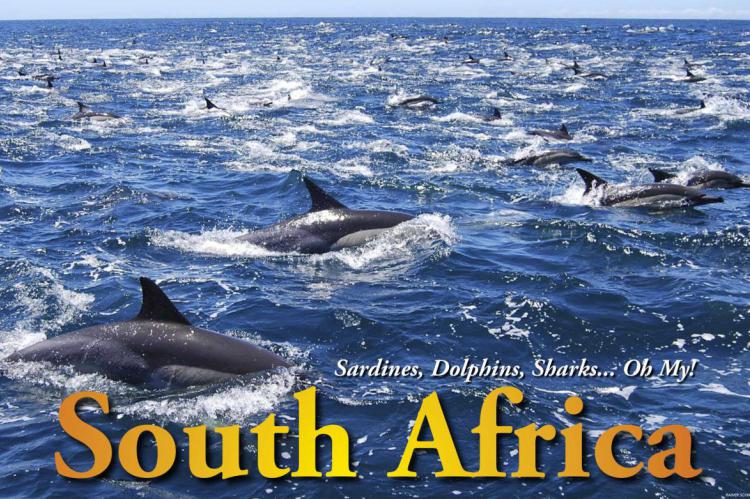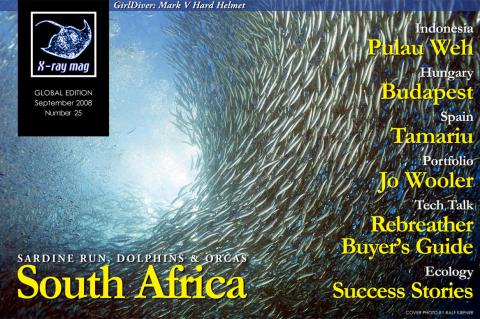Sardines, Dolphins, Sharks... South Africa!
Since times long forgotten, the promise of treasures such as diamonds, gold and platinum has attracted adventurers from all over the world to South Africa in the vain hope of finding new riches.
Tags & Taxonomy
Indeed, South Africa has long been a destination for adventurers world-wide since olden times. Hopes of finding new treasures, the excitement of the hunt and the pursuit of long held dreams heat up the mind of the explorer, painting fantasies in rainbow colors on the African plains. The desire to get away from the drudgery of everyday and familiar places inspires even the most inveterate home bodies and mamma’s boys. Of course, divers have the adventurous spirit in the blood, too, from the time they are born. This is exactly why the unexplored treasures of this country are attractive and magical to everyone and are the basis of our journey to this exotic world.
In 1487, the explorer Bartolomeu Dias of Portugal became the first European to reach the most southern tip of Africa. King John II of Portugal named it the Cabo da Boa Esperança, or Cape of Good Hope, because it led to the riches of India cherished by Europeans and traders. Later, Jan van Riebeeck established a new midway station (now Cape Town) at the Cape of Good Hope on 6 April 1652 for the Dutch East India Company. Soon, colonists from the Netherlands, France and Germany started to arrive.
Modern South Africa is an incredible combination of people of different races, cultures, religions and languages. In this society of diverse social classes there are 11 different languages spoken including Sepedi, Sesotho, Setswana, siSwati, Tshivenda, Xitsonga, Afrikaans, English, isiNdebele, isiXhosa and isiZulu. Thus, it is very symbolic that the nation’s motto is !ke e: |xarra |ke, or “Unity in Diversity”—literally, “Diverse People Unite”. The airlines of the Emirates offered us special weight terms as divers carrying extra heavy luggage with dive equipment. They rushed us over to this orange land of beauty, this mysterious country. What was waiting for us down there?
Catch the sardine
Each year, at the end of June and the beginning of July, the sardine migration travels along the south coast of the Republic of South Africa. Millions of sardines collect into huge schools and follow each other somewhere for important sardine business. Whales, dolphins, sharks, seals, sea birds, fishermen and divers cannot fail to attend this huge fish party. The place, where for a short time so many different sea animals collect together, is a big rarity on this Earth. It is an unique opportunity to watch the animals’ behavior in natural conditions, get very closely acquainted them, and take good shots. It is exactly for this reason that we are going to the “Wild Coast”, to Mbotyi River Lodge (www.mbotyi.co.za)—a very convenient place to organize a dive expedition.
Each week, there are meetings of about 50 people, madcaps and adventurers from all over the world. They are equipped up to the teeth with the most modern photo and video equipment and technology and are ready to dive even into the Devil’s horns just to test themselves and to capture some good photographic fortune from the sea. Businesslike South Africans from companies such as Sea-Air-Land (www.sea-air-land.com) and African Watersports (www.africanwatersports.co.za) provide top-end marine speed boat charters with experienced captians. Two microlight vehicles go out every day starting at sunrise to search the ocean for marine creature activity.
Action
This is the place where dolphins, whales and sharks hunt, corral and pack sardines together into a heap, or a bait ball, to make a convenient arrangement for dinner. Sea birds swoop down from the sky into the water when they see that the sardines are accumulated into a dense ball. Dinner is ready. Speed diving from altitudes of 20-30 meters above, the birds dive into the water—rowing with their wings and rolling by twisting their heads—pursuing the sardines with great enthusiasm.
The “Wild Coast” is refered to in this manner because the currents, waves and wind vary unpredictably and change quickly. From time immemorial, this place has had a bad reputation among seamen. Many brave seamen and good ships lie permanently on the bottom of the sea here. Getting to the sea from the surf is a dangerous adventure in Mbotyi, even with a very skilled skipper. In the beginning, the whole team tried to push the boat out as far away from the coast as possible as soon as it was possible.
All the crew members were dressed in life jackets—death clings to everything—but the only possible thing for us to cling to was the boat. Everything depended on the filigree skipper’s skill, who should, just like a surfer, slide the boat along the powerful ocean tidal waves—foam crested and roaring—rolling along the Wild Coast. Those who were unlucky and had an unskilled captain got soaked with streams of salty water, their equipment washed overboard and their boat overturned. But, we, not having experienced this everyday, left with the dawn and headed out to sea anyway. Struggling with the waves and rolling around in the surf, we drove on out to the sea in search of sardines.
The hunt
“The key to success is harmonious command work,” said Nic de Gersigny, already on his sixth Sardine Run expedition. “The skilled pilot in the motorized hang-glider flying above the sea all day long observes the weather, finds places of congestion of sardines and whales, dolphins, sharks or diving birds, and by radio set, directs our boat to that location. From a boat, we can only see the congestion of the birds in dense flight circling above the specific spot in the sea. But the birds often arrive later, following the whales and dolphins who are leading the formation of the sardine bait balls. Therefore, support from the sky is very important.”
At last, our boat is flying over the tops of the waves, falling into water troughs, and speeding towards our adventures. Our purpose (as guests in this neck of the woods) is to capture the sardine dinner on film. Finally, we found the first flock of diving birds. The sea was boiling from birds splashing and dropping out of the sky and down through the surface of the sea. It looked very serious, like a massive air attack and bombardment of the ocean. Involuntary ideas popped into my head, like how not to get under the birds’ bombardment—God forbid that a diving bird would cut my head open with a sharp beak! It seemed quite possible that one could lose one’s life under this intense bombardment.
Dolphins rushed in and zipped around the birds—their harmonious hunting groups jumping and leaping out of the water. As fast as it was possible, we were falling out of the boat with a loud command from our skipper. We grouped up and started the plunge (...)
Download the full article ⬇︎

Originally published
X-Ray Mag #25
Dive into South Africa where Andrey Bizyukin visits the Wild Coast, Ralf Kiefner takes awesome photographs of Sardine Run, and Harald Apelt profiles Rainer Schimpf's adventure playground for experts in Port Elizabeth where first-ever images capture orcas hunting dolphins! Apelt also takes us to another Mediterranean pearl -- Tamariu of Spain, while Simon Kong reports on MIDE and shows us paradise reborn on Pulau Weh, Aceh, Indonesia, after the 2004 tsunami, with colorful photographs by Asther Lau. Arnold Weisz highlights some of the success stories in marine conservation, while Swedish Coast Guard Commander Carl-Gustav von Konow discusses diving with dumped chemical weapons in the Baltic. Cedric Verdier offers an excellent Buyer's Guide to Rebreathers full of tips and advice. Kurt Amsler shows us how to maintain and care for our underwater photography gear, and Tim Hochgrebe brings us the winners of Underwater.com.au's photo competition. GirlDiver Cindy Ross takes on the challenge of the Mark V Hard Helmet. Explore Mulnar Janos cave under the streets of Budapest with JP Bresser, and view the exquisite portfolio of stainless steel sculptor and diver, Jo Wooler of Australia.





























